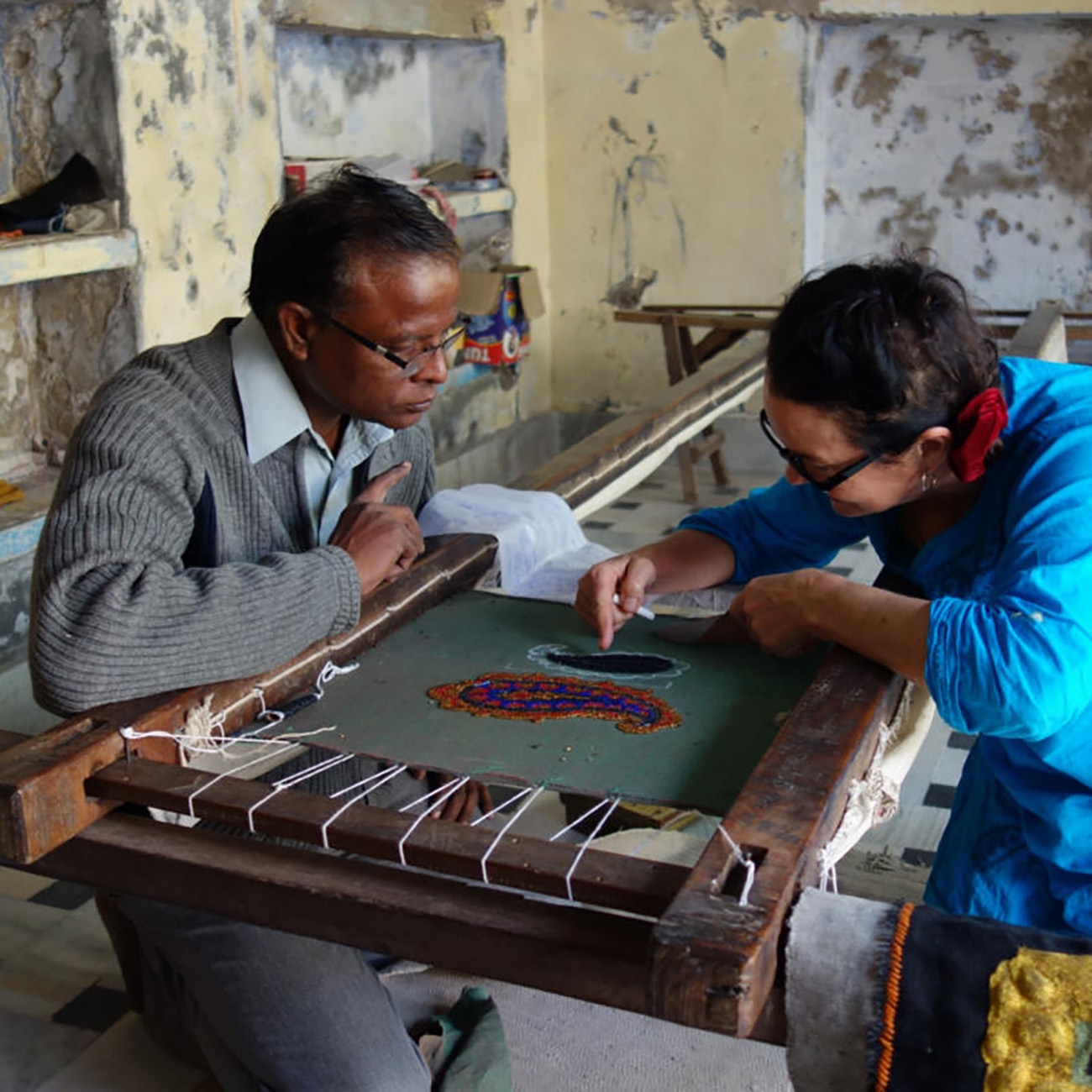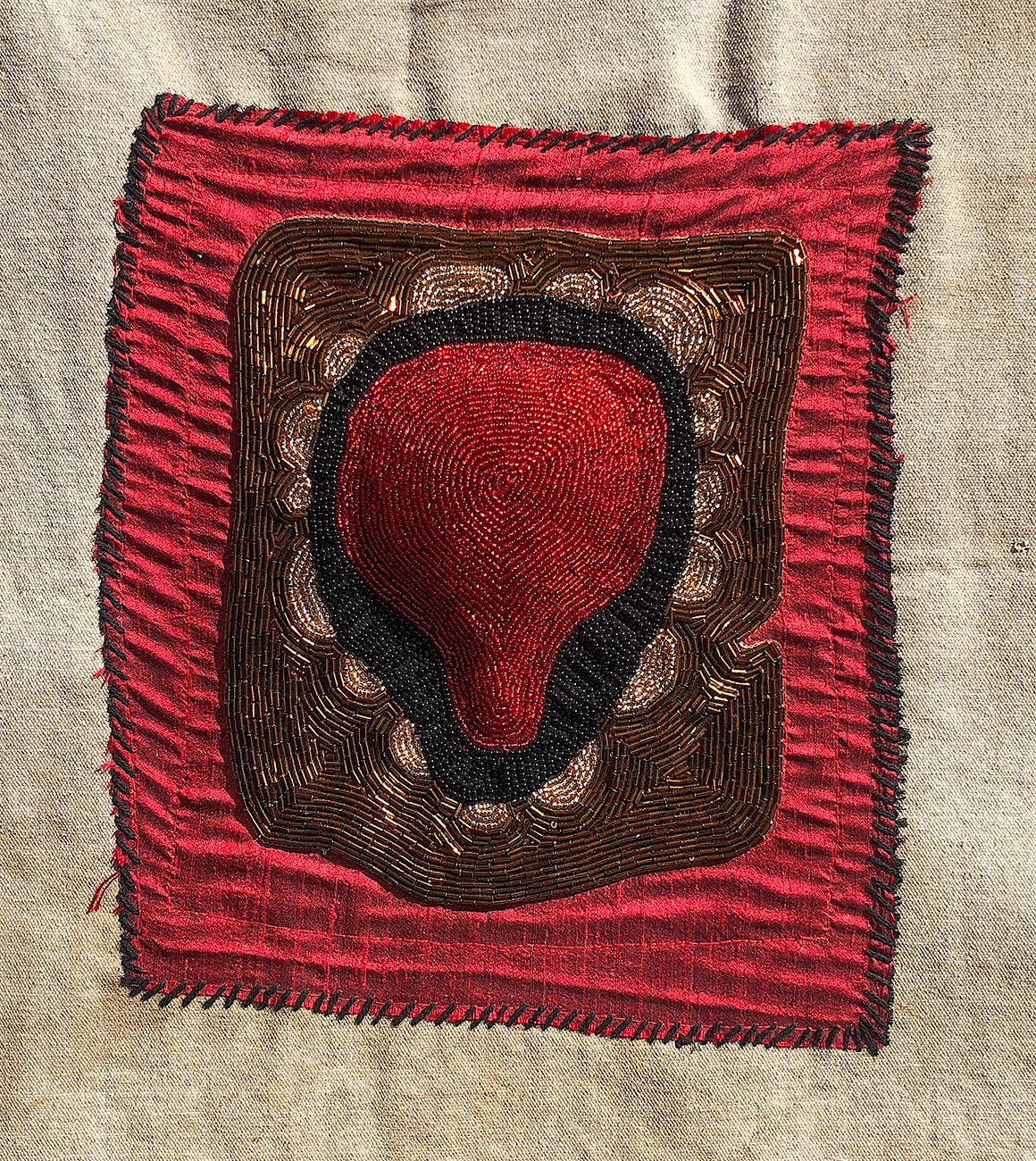Last year, multi-award-winning artist Anna Crichton made history by becoming the first woman to draw the op-ed column in the New Zealand Herald since its 1863 inception. Also in 2020, the esteemed Kiwi illustrator—whose satirical drawings have been published around the world in the likes The Australian, the New York Times, and Time magazine—broke new ground with her Mother India – Embroidered Tales exhibition. Three public galleries showcased a collection of embroideries that she designed, completed in collaboration with local craftspeople in the sacred city of Varanasi, during a three-month residency in late 2017 and early ’18. The collection is now being offered for sale.
Supported in part by The Asia New Zealand Foundation and The James Wallace Trust, the residency at Kriti Gallery was, admits the artist, “very comfortable”, but ever the adventurer, Anna made every effort to get out and discover what made Varanasi tick exploring its ancient river, thoroughfares, and surrounding lands. The resulting pieces she describes as reflections on “social issues in rural India”, particularly “those involving women”.
“I didn’t even really know quite what I was going to do when I got there,” she recalls. “I wanted to do something with embroidery and having searched Google could not find anything which was ‘conceptual’. There are Parisians and others doing beautiful designs for high-end labels who commission bead workers to put things on the back of jackets that they sell for thousands of dollars, but I haven’t seen anybody doing the conceptual artwork. People commenting on issues and on a world that is very different, but that is also very engaging and very exciting with lots of humour. You know, it’s easy to see how people get kind of addicted to India.”
Anna describes drawing as being an “insular process”, so gained great creative strength and inspiration from meeting—and collaborating with—the local people.
“It’s so enriching, spending time with them, rather that just wandering around looking at the sights. Eating with them, hearing about their families and all that kind of stuff, it’s what gives you a feel and a sense of a place.”

Anna describes drawing as being an “insular process”, so gained great creative strength and inspiration from meeting—and collaborating with—the local people.
During her first exploration of the city, Anna was approached by a young teenage girl who wanted to practise her English (“I was the first real life English-speaking person she’s ever met!”). They developed a bond and Anna employed her as a translator, helping her find collaborators, most notably an embroider called Subheash.
“It’s mostly the men who do the pretty embroidery work on women’s saris. He showed me his work and it was such beautiful craftsmanship, and I knew he was capable of realising my designs.”
Anna’s s16 stunning embroideries comment on topics such as labour, religion, and overpopulation. One, called ‘Ragpicker at 4am’ tells the story of woman that Anna would see at dusk, searching for recyclables to be sold “for a few rupees to a middle-man”. Swirls and circles—some slightly raised—of gold, crimson and black beads represent the night, the worker’s toil, her sweat, and her “bleeding soul”. Perhaps the most poignant of offerings is ‘Lost Identity’, a simple, sun-kissed fingerprint bordered by black fabric with saffron stitching. This represents the story of Gita Manjhi, who was relying on government rice rations to feed her family following years of drought. Through manual work, her fingerprints became so worn that they were unable to be accepted as a form of ID.
“Some of the things that you see and read about are just horrible, unbelievable,” says Anna. “It can be overwhelming at times, especially the stories that involve children—their exploitation and forced marriages.”

The canvases retain stains and imperfections that “speaks of the street”
Further adding to the evocative potency and authenticity of the embroideries is that the glass beads have been ingeniously handstitched onto village loomed cloth atop of sturdy canvas backing that once formed the canopies of the local pedal rickshaws. The canvases retain stains and imperfections that “speaks of the street”, betraying their former lives and contrasting beautifully against the vibrancy of Anna’s designs.
“I think it was on the second day I noticed a rickshaw in front of me that had this material flapping away at its back,” chuckles the artist. “It just occurred to me how cool it would be to use it as a backdrop for the embroideries.”
Amusingly, Anna then developed a reputation among the local rickshaw drivers as the eccentric white lady who’d patrol the lanes with a pair of scissors and a razor blade in search of potential canvas scraps. She paid them generously enough that the men would often flag her down to offer sections of their vehicles’ roofs.
“Crowds would gather round wondering what was going on, which was really embarrassing at first, but then you just go with it!”
Though she had travelled around India many years prior (and more recently stayed in Ahmedabad for another project involving wood carving and silk printing), Anna laments that there never seems to be enough time to really savour what is one of the most the world’s most wondrous and profound of cultures. And who knows when that time will come again.
“You come to realise how constrained and precious we are in Western countries, worrying about silly things,” she says. “We really need to learn to take more time to take stock, to stop and consider what is really important.”
Anna wished to acknowledge and thank The James Wallace Foundation and The Asia New Zealand Foundation for their generous support in helping to fund her residency in Varanasi. The Mother India – Embroidered Tales exhibition currently on at Railway Street Gallery. Anna will be doing an artist talk on Slow Art Day, 2 April, 1 pm, in the gallery. Ten percent of sales will be given to the craftspeople Anna collaborated with in India. For updates and more information about the artist and her work, visit annacrichton.com.






